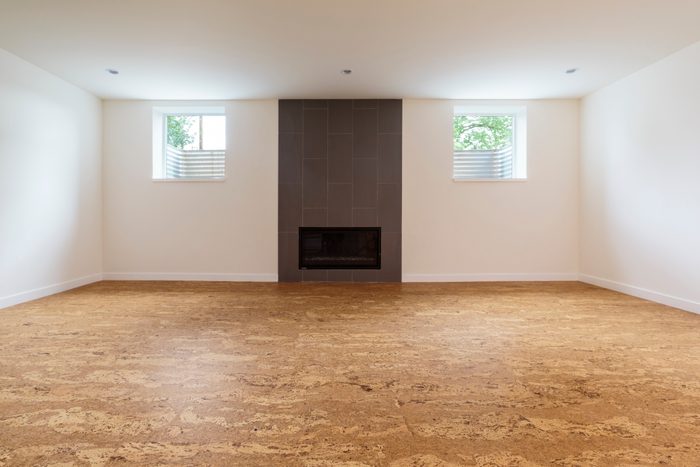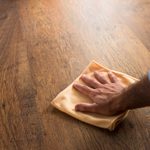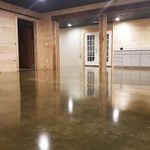7 Reasons You Should Consider Cork Flooring for Basements

Although installing cork in the basement sounds like a dicey proposition, it's actually a good idea. Cork is naturally resistant to mold and rot.
When I bought the house I now live in, it featured a recently-built addition with an unfinished interior. The foundation was an on-grade concrete slab. My business partner and I, after considerable discussion, decided to install cork flooring. That was, in retrospect, the Best. Decision. Ever.
As a flooring guy, I put it in. Installing cork was as easy as installing a laminate floor, since the cork planks were engineered with a similar locking mechanism. The floor complemented the dramatic orange color scheme of the walls and ceiling.
The combination created a warm, inviting space with plenty of visual interest, and the floor has stood the test of time. After 17 years, none of it looks worn, not even in high-traffic areas.
On This Page
Where Does Cork Flooring Work Best?
Would we have been as lucky with a below-grade installation, like a basement? Perhaps, because the house is in a semi-arid location with a low water table.
Cork comes from tree bark. It absorbs moisture, so it wouldn’t do well in wet conditions. If you’re prepared to adequately waterproof the subfloor, however, it’s a great option for a humid basement with no active leaking. Why? Because cork resists mold growth.
If you’re looking for basement flooring, here are seven reasons to consider cork.
Hypoallergenic and Antimicrobial
Even a watertight basement is bound to have moisture problems if it lacks good ventilation. Moisture condenses from humid air when it contacts a cold surface like the floor. Believe it or not, cork performs well in these conditions because of a substance called suberin, which gives cork its waxy appearance.
Suberin in the bark of the Cork Oak tree (Quercus Suber) protects it from insect and rot damage. It remains effective when that bark becomes flooring. Cork’s resistance to microbial growth makes it a great choice for allergy sufferers.
Eco-Friendly and Sustainable
Cork is derived from the outer layer of the Cork Oak, which grows naturally in southwestern Europe (mostly Portugal and Spain) and in northern Africa. The bark can be harvested without damaging the tree. An average tree, which lives for up to 200 years, can be harvested up to 15 times.
Harvesting is traditionally accomplished by hand. Because of recent reforestation programs, the world’s supply of cork is actually increasing. When a cork floor reaches the end of its life and must be thrown away, it naturally biodegrades.
Affordable and Easy to Install
Depending on the quality, cork flooring can cost $2 to $12 per square foot. (Ours was $3.25 per square foot in 2006.) That range allows plenty of leeway for the budget-conscious, especially considering you probably don’t want a top-grade product in the basement.
Cork floorboards come in two formats: glue-down and snap-together. Both are DIY-able. Because snap-together boards float over the subfloor, they allow for water-resistant underlayments and are the better choice for basements. You can cut them with power saws and they’re easy to install.
Provides Cushion and Insulation
The cork floorboards in our house are 5/8-in. thick. They include a 3/16-in. cork design layer, fiberboard core and cushioning underlayment, also made from cork. The design layer and underlayment are compressible, which makes the floor extremely comfortable to walk on. Products differ from brand to brand, but most have similar characteristics.
The thickness of the floorboards provides needed thermal insulation for the basement. They also provide sound insulation, though this is more important for upper floors. Cork’s resilience helps absorb noise and makes for a quieter space.
Lots of Design Choices
We opted for a product with a dramatic burl pattern. It’s possible to find cork floors with patterns so subtle they appear almost monochromatic, while others are manufactured to look like wood planks. The natural reddish wood tones of cork usually predominate, but some manufacturers add dyes to turn it gray or white. Looking for more options? Check out the benefits of basement wood flooring.
Long Lasting
Because of its natural rot resistance, cork flooring has been known to last 40 years or more, although warranties are usually much shorter. Ten years is typical. Our floor is 17 years old and shows few signs of age, so it will probably last at least twice as long.
Of course, no flooring material will last long in a damp basement. So to get the most from cork in the basement, it’s imperative to keep the space dry.
Easy to Keep Clean
Cork flooring is typically shipped with a durable urethane coating. Once installed, it needs little more maintenance than occasional sweeping.
Spills should be wiped up immediately because cork can stain. Depending on the pattern, though, some stains might not even be noticeable. A variegated pattern also effectively masks scuff marks and other defects.
You can’t refinish a cork floor, but you can restore the shine by applying a new coat of polyurethane. But first, be sure to do a thorough cleaning and light scuffing of the old finish with fine (150 grit) sandpaper.



